

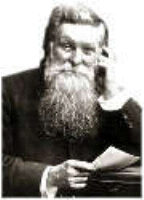
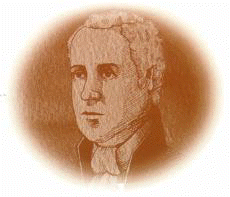


Notable Relatives
"From this small hill by the Glazert Burn
They bequeathed a Soul unto our Name
From Hist'ries Heart we may discern
Who We are and from Whence we came
Whose Bearer's deeds did Greatness earn
For Dunlop, Dunlap, DeLap Same"
MJD from "The Black'n'Blue"
2004
Scotland/Ireland/USA/Australia/Canada/India/Caribbean/France/China

see
Scotland
for many more


Frances Wallace Dunlop of Dunlop House was
a frequent correspondent of Robert Burns, more than any other. His last writing
was to her 4 days before his death, and the last thing he read was her answer.
Robert Burns and Mrs. Dunlop

see
Ireland
for many more
 John Boyd Dunlop (1840-1921). A device that is used daily by
hundreds of millions (if not billions) of people around the world was developed
in the last century by Scotsman John Boyd Dunlop. Born on February 5, 1846 in
Dreghorn, North Ayrshire, Dunlop was originally a successful veterinarian
working near Belfast. Later on however, he would become instrumental in creating
the first usable pneumatic tire, a device which is essential in the modern
automobile. Dunlop was not the first person to invent the device (it was first
conceived by another Scotsman, Robert William Thomson, in the 1840's), but
Dunlop was the first to develop and patent a practical version of it.
John Boyd Dunlop (1840-1921). A device that is used daily by
hundreds of millions (if not billions) of people around the world was developed
in the last century by Scotsman John Boyd Dunlop. Born on February 5, 1846 in
Dreghorn, North Ayrshire, Dunlop was originally a successful veterinarian
working near Belfast. Later on however, he would become instrumental in creating
the first usable pneumatic tire, a device which is essential in the modern
automobile. Dunlop was not the first person to invent the device (it was first
conceived by another Scotsman, Robert William Thomson, in the 1840's), but
Dunlop was the first to develop and patent a practical version of it.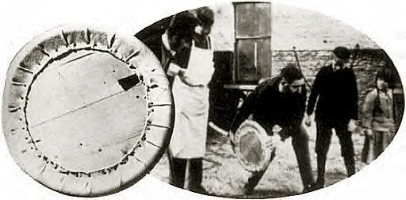
In the long tradition of major discoveries and inventions
coming about through coincidence, accident or necessity, the beginning of
Dunlop's legacy occurred when, in 1888, he was watching his son ride his
tricycle. Noticing that his son was encountering difficulty and discomfort while
riding over cobbled ground, Dunlop realized that this was because of the
vehicle's solid rubber tires and began looking for a way to improve them.
The solution he came up with was a rubber tube filled with air to give it
cushioning properties. Dunlop patented the design and it wasn't long before
bicycle and automobile manufacturers recognized the design's potential
usefulness in their fields. Within ten years of patenting the device, it had
almost entirely replaced solid tires and had been implemented for use in
automobiles by Andre and Eduardo Michelin. Through the company he founded,
Dunlop Tires, his name is still associated with the automobile industry today.
Little
Dunlop's tricycle

see
United States
for many more

-John Dunlap (1746-27 Nov 1812), a Scots-Irishman
from Strabane, Co. Tyrone, Ulster, printed the first daily newspaper in the US,
the "General Advertiser" , in Philadelphia. He was appointed printer to the
Continental Congress in 1773, printing not only the first copy of the
Declaration of Independence-at the time called "the Dunlap Broadside" (see
above- one of 26 copies still in existence) but also the Constitution of the
United States. John founded the 1st Troop of Philadelphia City Calvary in 1774,
seeing action in the campaign of 1776-77 at Princeton and Trenton. John also
subscribed L4,000 to the American Army in 1780 and owned 98,000 acres in
Virginia and the land on which Utica, Ohio now stands. (His wife, Janet
Rutherford, was the niece to Benjamin Franklin's wife. The couple were frequent
visitors and close friends of the Franklin's. Janet was descended from the
Rutherfords of Hunthill, Strabane, Northern Ireland....distant cousins of Sir
Walter Scott!...submitted by Gary Harding)
Dunlap Records
Gray's
Printing

see
Australia
for many more
 Sir
Edward "Weary" Dunlop (1908-1993)An
Australian Army Surgeon who was famous for treating soldiers in Japanese POW
camps in Indonesia during WWII. His care for soldiers in Burma building a 420
kilometer railway under extreme conditions made him a legend in Australia.
During the course of his life Dunlop received numerous honours and awards in
recognition of his civic, sporting, educational, military and medical
achievements. These included the Order of the British Empire (1947), Knight
Bachelor (1969), Companion of the Order of Australia (1987), Knight Grand Cross,
Order of St John of Jerusalem (1992), Knight Grand Cross (1st Class) of the Most
Noble Order of the Royal Crown of Thailand (1993). He was an Honorary Fellow of
the Imperial College of London, an Honorary Fellow of the Royal College of
Surgeons of Edinburgh, Honorary Life Member of the RSL and Life Governor of the
Royal Women's Hospital and the Royal Victorian Eye and Ear Hospital. In 1977 he
was named Australian of the Year and in 1988 one of the 200 Great Australians.
More than 10,000 people lined the streets of Melbourne for the State funeral of
the "Surgeon of the Railway" in 1993. Sir Edward's dying wish to rejoin his
comrades who perished on the railway was respected in 1994 when his ashes were
scattered at Hellfire Pass by his family in the presence of friends, admirers
and servicemen.
Sir Edward died in 1993 shortly after receiving the Order of the White
Elephant from His Majesty the King of Thailand.
Sir
Edward "Weary" Dunlop (1908-1993)An
Australian Army Surgeon who was famous for treating soldiers in Japanese POW
camps in Indonesia during WWII. His care for soldiers in Burma building a 420
kilometer railway under extreme conditions made him a legend in Australia.
During the course of his life Dunlop received numerous honours and awards in
recognition of his civic, sporting, educational, military and medical
achievements. These included the Order of the British Empire (1947), Knight
Bachelor (1969), Companion of the Order of Australia (1987), Knight Grand Cross,
Order of St John of Jerusalem (1992), Knight Grand Cross (1st Class) of the Most
Noble Order of the Royal Crown of Thailand (1993). He was an Honorary Fellow of
the Imperial College of London, an Honorary Fellow of the Royal College of
Surgeons of Edinburgh, Honorary Life Member of the RSL and Life Governor of the
Royal Women's Hospital and the Royal Victorian Eye and Ear Hospital. In 1977 he
was named Australian of the Year and in 1988 one of the 200 Great Australians.
More than 10,000 people lined the streets of Melbourne for the State funeral of
the "Surgeon of the Railway" in 1993. Sir Edward's dying wish to rejoin his
comrades who perished on the railway was respected in 1994 when his ashes were
scattered at Hellfire Pass by his family in the presence of friends, admirers
and servicemen.
Sir Edward died in 1993 shortly after receiving the Order of the White
Elephant from His Majesty the King of Thailand.

see
Canada
for many more
Dr. William "Tiger"
Dunlop(1792-1848) A surgeon in the Connaught Rangers of
 Britain, William was active in the campaigns against the Americas in 1813, 1814,
and 1815 (War of 1812). William Dunlop came to Canada in 1813 as a 21 year-old
assistant surgeon with the 89th British Foot. Like other memorable war doctors,
he was faced with seemingly impossible tasks. After the battle of Chippawa,
Dunlop worked alone on 220 men from both armies because the chief surgeon had
been sent home and the chief assistant had fallen ill from fatigue. Apparently,
Dunlop carried on alone for more than two full days, barely sitting down and
stopping only to eat and change clothes.
Britain, William was active in the campaigns against the Americas in 1813, 1814,
and 1815 (War of 1812). William Dunlop came to Canada in 1813 as a 21 year-old
assistant surgeon with the 89th British Foot. Like other memorable war doctors,
he was faced with seemingly impossible tasks. After the battle of Chippawa,
Dunlop worked alone on 220 men from both armies because the chief surgeon had
been sent home and the chief assistant had fallen ill from fatigue. Apparently,
Dunlop carried on alone for more than two full days, barely sitting down and
stopping only to eat and change clothes.
The regiment was afterward transferred to Calcutta, where William contracted to
exterminate tigers from the island in the Ganges named Saugor. after having
killed an immense number of these royal game, he was called "Tiger" by the
natives.
After returning to native Scotland in Edinburgh for awhile, he embarked on a
scheme in 1826 with John Galt called "the Canada Company". In Canada he became
distinguished as a "chopper", a founder of cities along Lake Huron, a counsellor,
friend and guide to emigrants and settlers in Upper Canada, and as a humorist
and novelist. Dr Dunlop wrote a highly regarded manual in 1826 entitled
"Statistical Sketches of Upper Canada" (John Murray, London) consisting of 126
pages for the use of emigrants.
He was described by a colleague: "This
remarkable biped stands 6 feet 3 inches; 2 feet 8 inches across the shoulders,
his head crowned with red locks." Dr Dunlop was also a Member of the Provincial
Parliament. Gairbread Log-House, at Colborne Township (Huron District) was the
well-visited home of Dunlop and his brother, Capt Robert Dunlop. It was the
center of jovial entertainment in the wilderness, a meeting place, a refuge for
all comers. Dr Dunlop was eulogized by a friend thusly: "Farewell, noble savage!
wild as thy woods! When shall we again revel in the rich luxuriance of thy
anecdotes or shake under the titanic bray of thy laughter?! ...Though Toryism
were expelled from all the rest of the globe, it would find shelter in the log
house of Dunlop!" From 1841 until 1846 he represented Huron Riding in the
Legislative Assembly. He died in 1848.
Battle of
Lundy Lane, Niagara Falls and Dr Dunlop

France
-Samuel and John Hans
DeLap were American agents in Bordeaux, France during the American
revolution. The Continental Congress records show secret letters written to them
concerning "shopping lists " of supplies for the fledgling American Army

Caribbean
-Francis DeLap of
Antigua and his brother, Robert DeLap, Provost
Marshall in Jamaica during the American Revolution, were thought to have roles
helping the shipment of those supplies sent by Samuel and John DeLap of France,
since said supplies came by the way of the West Indies and then to Boston.
James B. Delap, of the parish
of Westmoreland in Jamaica 1835...also registered were Andrew Delap in 1816, Ann
Delap in 1825 and Lilly Delap in 1830...all as slaveholders and landowners

China
-Dr. Albert Menzo Dunlap, known as A.
M. Dunlap, M.D., spent nearly all of his professional career teaching and
practicing medicine in China. He was one of the leading ear, nose, and throat
doctors in the Far East. Hundreds of Americans resident in China were among his
patients, as were such notables as the Panchen Lama, Count Galeazzo Ciano, and
two of the Soong Sisters. He also treated thousands of Chinese, most of whom are
entirely unknown to the Western World. He and his twin sister, Isabel, were born
January 15, 1884, in Savoy Illinois. He graduated from the University of
Illinois in 1906, attend Washington University in St. Louis, and graduated from
Harvard Medical School in 1910. A few weeks later he married Eva May Wyman,
daughter of Reverend James Monroe Wyman.
Before he began practicing, Dr. Dunlap joined a few other recent graduates to
form the Harvard Medical School of China, with the endorsement and moral backing
of the Harvard Medical School. He moved to Shanghai and served as Head of the
Department of Eye, Ear, Nose, and Throat Diseases from 1911 until 1916, when the
Rockefeller Foundation set up the Peking Union Medical School and absorbed the
Harvard Medical School of China. Dr. Dunlap returned to the United States to
recruit additional faculty, and between 1918 and 1931 he was in charge of the
Department of Nose, Throat and Ear Diseases at PUMC, part of this time also
serving as Dean. In 1931 the Dunlap family, now including three sons and three
daughters, returned to Shanghai, where Dr. Dunlap entered private practice and
headed the Nose, Throat and Ear Diseases Department of St. John's University
Medical School. During the Japanese occupation of China in World War II, Dr. and
Mrs. Dunlap and their youngest son were repatriated on the second voyage of the
M.S. Gripsholm in 1943. He was Visiting Professor of Otolaryngology at the
University of Chicago until 1946, when he returned to Shanghai and resumed
private practice and teaching.
Following the Communist takeover of Shanghai in 1949, Dr. and Mrs. Dunlap were
under increasingly confining restrictions and were not permitted to leave China
until October 1952. His experiences and his reactions to the Communist regime
are recounted in his book "Behind the Bamboo Curtain," based on letters which he
wrote during this period and sent to friends and relatives in the U.S. For six
months in the winter of 1952 - 1953, Dr. Dunlap was Visiting Professor of
Otolaryngology at the University of Hong Kong. He then returned to the United
States for good, settling south of Alexandria, Virginia.
Mrs. Dunlap, the illustrator of "Behind the Bamboo Curtain," died December 1,
1966, and Dr. Dunlap died November 15, 1973. (submitted by his Granddaughter,
Nancy Butler of Texas)

see
India
for many more
Sir James Robert Dunlop Smith,
1858-1921. Educated at Edinburgh University and
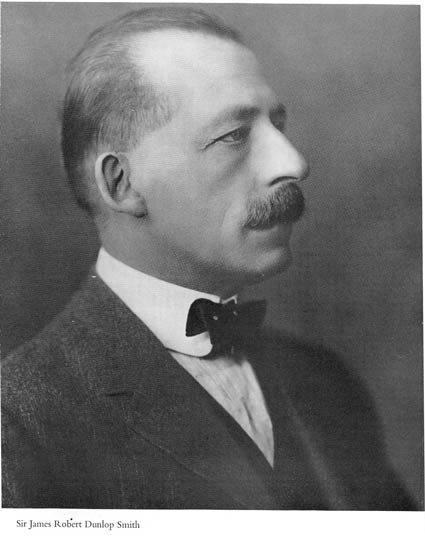 the Royal Military College, Sandhurst; Second Lieutenant, 1878; MA, 1878;
entered the 22nd Regiment, 1879; transferred to Indian Staff Corps, 1882;
Private Secretary and ADC to the Lieutenant-Governor of the Punjab, 1883-1887;
Settlement Officer, Sialkot, 1877-1896; Commissioner, Hissar, 1896-1897;
Director of Land Records and Agriculture, Punjab, 1879-1899; Famine
Commissioner, Rajputana, 1899-1900; CIE, 1901; Political Agent, Phulkian States
(Nabha, Patiala, & Jind) and Bahawalpur, 1901-1904; became Lt.-Colonel, 1905;
Private Secretary to the Viceroy of India, Lord Minto, 1905-1910; CSI, 1909;
Knighted, KCSI 1910; Political ADC to the Secretary of State for India,
1910-1919. Friend and advisor to Rudyard Kipling
the Royal Military College, Sandhurst; Second Lieutenant, 1878; MA, 1878;
entered the 22nd Regiment, 1879; transferred to Indian Staff Corps, 1882;
Private Secretary and ADC to the Lieutenant-Governor of the Punjab, 1883-1887;
Settlement Officer, Sialkot, 1877-1896; Commissioner, Hissar, 1896-1897;
Director of Land Records and Agriculture, Punjab, 1879-1899; Famine
Commissioner, Rajputana, 1899-1900; CIE, 1901; Political Agent, Phulkian States
(Nabha, Patiala, & Jind) and Bahawalpur, 1901-1904; became Lt.-Colonel, 1905;
Private Secretary to the Viceroy of India, Lord Minto, 1905-1910; CSI, 1909;
Knighted, KCSI 1910; Political ADC to the Secretary of State for India,
1910-1919. Friend and advisor to Rudyard Kipling


Compiled by Mike Dunlap from published
sources,
and by many contributions from Dunlops all over the Globe.
Send comments, pictures or submissions of
Dunlop people to ClanDunlap@gmail.com
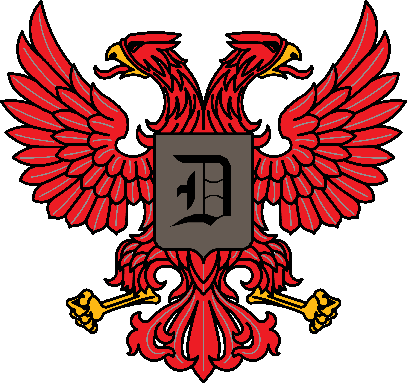




![]()




